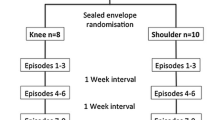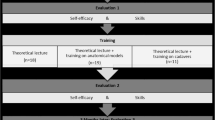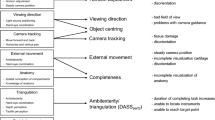Abstract
Aim of this study is to introduce, evaluate, and propose a basic arthroscopy training course with interactive methods as using bovine knees, joint models but mainly focusing on practices with motor skill-learning devices. This study presents the results of a skill training program which is based on “motor skill training” theory and using “bovine knees” to simulate a specific task as arthroscopy both in education and evaluation. The participants gave feedback regarding their expectations, fulfillment, and self-evaluation on the degree of their improvement levels, after which their skills were evaluated by an expert while they performed the arthroscopic procedure. During this evaluation of the task, a four-dimensional checklist which was prepared previously by the consensus of three experts was used, and a global grading of each rater was added at the end of the checklist. In this 2-day course, small group teaching sessions are integrated with active and experiential learning methods consisting of short presentations by the educators, demonstrations using joint models and audio-visual teaching material, and significant continuous feedback by the teachers during the proceedings. Participants’ expectations and post-course feedback results were obtained using a brief questionnaire which involved mostly open-ended questions. The self-rating of “own basic diagnostic arthroscopy skill” on a scale of 0–10 was completed by the participants both previous to and following the course to establish a student-centered learning environment. Overall rating of the course was asked on a 1–5 (poor–excellent) Likert scale. The questioning of the participants who took part in the course during the last five terms involved a 100% feedback. The overall rating of the course was 4.36 ± 0.47 on the 1–5 scale. The majority of the participants (90%) mentioned that the course met their expectations. The most beneficial activities were accepted to be the arthroscopic procedure applications on bovine knee, repetition of the manipulations under the supervision of the trainers, continuous feedback by experienced staff, and chance for immediate correction during the procedures (35/64). Pre- and post-course self-ratings of the participants inquiring about their ability to perform an arthroscopy alone showed significant improvement (4.2 vs. 7.7 P = 0.000, paired samples t test). All participants were found to be competent in the evaluation of their diagnostic arthroscopy skills on bovine knees. To design a skill teaching course based on the needs of the trainees, focusing on basic motor skill training exercises, and using bovine knee as a simulator is a safe, inexpensive, humanistic, and replicable method that proves a foundation for basic arthroscopic skills learning prior to patient encounter.
Similar content being viewed by others

References
Bloom M, Rawn CL, Salzberg AD, Krummel TM (2003) Virtual reality applied to procedural testing: the next era. Ann Surg 237:442–448
Dion YM, Gaillard F (1997) Visual integration of data and basic motor skills under laparoscopy. Influence of 2––D and 3––D video––camera systems. Surge Endosc 11:995–1000
Dubrowski A, Backstein D (2004) The contributions of kinesiology to surgical education. J Bone Joint Surg Am 86:2778–2781
Folse JR (1996) Surgical education-addressing the challenges of change. Surg 120:575–579
Karahan M, Unalan PC, Bozkurt S, Odabaş I, Akgun U, Cifcili S, Lobenhoffer P, Aydın AT (2009) Correlation of basic motor skills with arthroscopic experience. Acta Orthop Traumatol Turc 43:49–53
Kocabey Y, Taser O, Doral MN, Demirhan M, Isıkan EU, Nyland J, Sarban S, Bozdağ E, Sunbuloglu E, Caborn D (2005) The effect of anterior or posterior tibial tunnel placement of a soft tissue graft with a soft tissue interference screw on fixation biomechanics. Acta Orthop Traumatol Turc 39:432–436
Neequaye SK, Aggarwal R, Brightwell R, Van Herzeele I, Darzi A, Cheshire NJ (2007) Identification of skills common to renal and iliac endovascular procedures performed on a virtual reality simulator. Eur J Vasc Endovasc Surg 33:525–532
Neiman Z (1989) Teaching specific motor skills for conducting to young music students. Percept Mot Skills 68:847–858
Newmark J, Dandolu V, Milner R, Grewal H, Harbison S, Hernandez E (2007) Correlating virtual reality and box trainer tasks in the assessment of laparoscopic surgical skills. Am J Obstet Gynecol 197:546e1–546e4
Pinney SJ, Mehta S, Pratt DD, Sarwark JF, Campion E, Blakemore L, Black KP (2007) Orthopaedic surgeons as educators: applying the principles of adult education to teaching orthopaedic residents. J Bone Joint Surg Am 89:1385–1392
Reznick RK (1993) Teaching and testing technical skills. Am J Surg 165:358–361
Schuwirth LWT, Southgate L, Page GG, Paget NS, Lescop JMJ, Lew SR, Wade WB, Baron-Moldanado M (2002) When enough is enough: a conceptual basis for fair and defensible practice performance assessment. Med Edu 36:925–930
Straub RO, Terrace HS (1981) Generalization of serial learning in the pigeon. Anim Learn Behav 9:454–468
van der Vleuten C (2000) Validity of final examinations in undergraduate medical training. BMJ 321:1217–1219
Wass V, van der Vleuten C, Shatzer J, Jones R (2001) Assessment of clinical competence. Lancet 357:945–949
Author information
Authors and Affiliations
Corresponding author
Rights and permissions
About this article
Cite this article
Unalan, P.C., Akan, K., Orhun, H. et al. A basic arthroscopy course based on motor skill training. Knee Surg Sports Traumatol Arthrosc 18, 1395–1399 (2010). https://doi.org/10.1007/s00167-009-0994-7
Received:
Accepted:
Published:
Issue Date:
DOI: https://doi.org/10.1007/s00167-009-0994-7



